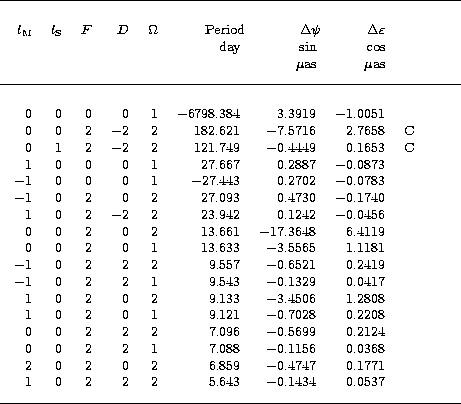 |
Our series, called REN2000 (REN for Rigid Earth Nutation) are ready and available at this level of truncation. They give the nutation for the axis of angular-momentum, the axis of figure and the axis of rotation, in separate files. The basic plane of reference and the basic point of reference are respectively the mean dynamical ecliptic and the mean equinox of the date. Hamiltonian theory is very well suited to give the nutations with respect to a moving point (equinox of the date) and a moving plane (the mean dynamical ecliptic), for the change of canonical variables caused by their motions with respect to the fixed ecliptic and the fix equinox of the epoch is quite straightforward (Kinoshita 1977).
The corrected value for the general precession in longitude as pointed out by various authors and using different techniques (Herring et al. 1991; Miyamoto & Soma 1993; Steppe et al. 1994; Williams et al. 1993; Charlot et al. 1995) has been taken into account as well as more accurate recent values for the indirect and direct planetary effects (Souchay & Kinoshita 1996, 1997). Notice that for this last effect, a comparaison was done in this last paper with respect to previous results by Williams (1995), which showed a particularly remarkable agreement.
 |
In Table 4, we present the largest Oppolzer terms which characterize the difference between the nutations for the figure axis and for the angular momentum axis, and in Tables 5.1 and 5.2 we give the values of the leading coefficients of rigid Earth nutation for the angular momentum axis and the figure axis, both in longitude and in obliquity. Little changes can be remarked with respect to the values listed by Souchay & Kinoshita (1996). They are due to the improved second-order computations related to the crossed-nutation effect and the coupling effect as described in the precedent chapters and illustrated by Tables 1 and 2.
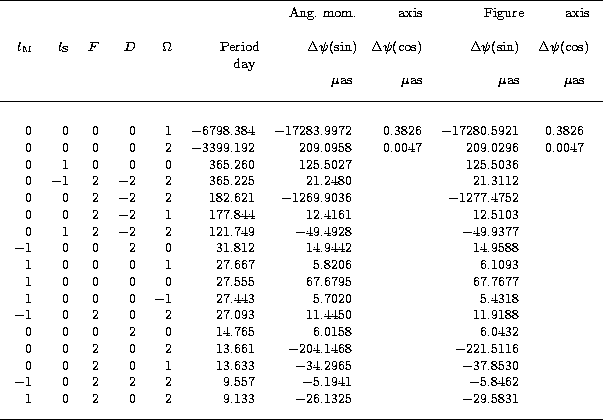 |
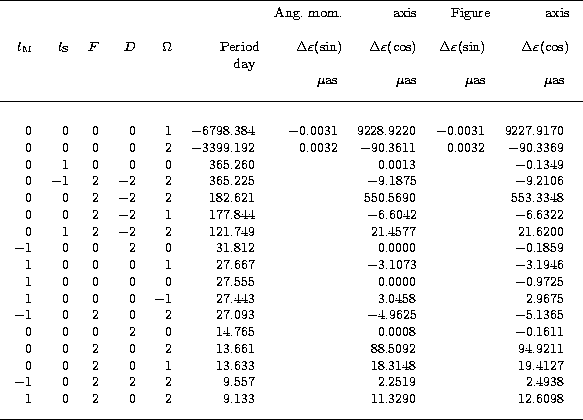 |
Our tables REN-2000 include also the semi-diurnal coefficients related to the triaxiality
of the Earth (Souchay & Kinoshita 1997), as well as the diurnal, semi-diurnal
and 1/3 d period nutations related to the tesseral harmonics C3,n and S3,n,
(n=1,2,3).
These last ones were studied in a complementary paper by
Folgueira et al. (1998a), by taking
the same Hamiltonian method as in the present paper. Notice that the amplitude of these
waves reaches ![]() as was already noticed by Bretagnon et al. (1997).
The waves related to the tesseral harmonics C4m,n and S4m,n
(Folgueira
et al. 1998b) are also taken into account, as well as the two waves up to our level of
truncation (
as was already noticed by Bretagnon et al. (1997).
The waves related to the tesseral harmonics C4m,n and S4m,n
(Folgueira
et al. 1998b) are also taken into account, as well as the two waves up to our level of
truncation (![]() ) for the influence of J4
(Souchay & Kinoshita
1996).
) for the influence of J4
(Souchay & Kinoshita
1996).
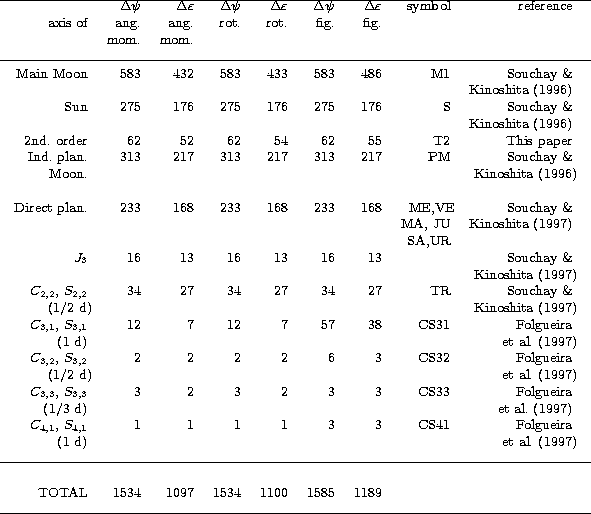 |
In order to have a clear insight of various contributions to the rigid Earth nutation,
we list in Table 6 the number of coefficients related to each specific effect,
up to ![]() . The symbol used in the tables in order to reckon the effect involved,
is indicated here. At last, the bibliographic reference from which the coefficients of
our tables REN-2000 have been picked up is also given for each specific effect.
For a better understanding of the presentation of our tables REN-2000, we give in
the following some comments and remarks that we would like to present, with respect
to each contribution.
. The symbol used in the tables in order to reckon the effect involved,
is indicated here. At last, the bibliographic reference from which the coefficients of
our tables REN-2000 have been picked up is also given for each specific effect.
For a better understanding of the presentation of our tables REN-2000, we give in
the following some comments and remarks that we would like to present, with respect
to each contribution.
Main problem of the Moon
The major contribution to the nutation, as considering the importance of the effect
and of the number of coefficients, comes from the Main Problem of the Moon, that
is to say from its orbital motion when being disturbed only by the Sun.
It is worthy to notice that the arguments of the terms coming from this effect are
expressed in function of the only Delaunay arguments F, D, ![]() ,
, ![]() and
and ![]() (Chapront-Touzé & Chapront 1988).
The related nutation has been calculated with up-to-date analytical Fourier series of
Moon coordinates taken in the recent version of ELP-2000
(Chapront-Touzé & Chapront 1988), with a truncature at a relative 10-11
for all the Fourier series concerned in the calculations in order to avoid cut-off
problems (Souchay & Kinoshita 1996).
The Moon's coordinates in ELP2000 are given with respect to the moving
ecliptic and equinox of the date, which constitute a precious advantage for our theory
is itself established starting from the moving ecliptic and equinox. Therefore we
have not further coordinates transformations to carry out, as it would be the
case if our basic equations were given in an inertial frame. Concerning the
nutation due to the main problem of the Moon at the first-order,
we find no significant difference with
older calculations (Kinoshita & Souchay 1990), except for the contribution coming
from the planetary tilt effect described in detail and calculated by
Williams (1994) and recalculated by
Souchay & Kinoshita (1996), and which only
influences the coefficient with argument
(Chapront-Touzé & Chapront 1988).
The related nutation has been calculated with up-to-date analytical Fourier series of
Moon coordinates taken in the recent version of ELP-2000
(Chapront-Touzé & Chapront 1988), with a truncature at a relative 10-11
for all the Fourier series concerned in the calculations in order to avoid cut-off
problems (Souchay & Kinoshita 1996).
The Moon's coordinates in ELP2000 are given with respect to the moving
ecliptic and equinox of the date, which constitute a precious advantage for our theory
is itself established starting from the moving ecliptic and equinox. Therefore we
have not further coordinates transformations to carry out, as it would be the
case if our basic equations were given in an inertial frame. Concerning the
nutation due to the main problem of the Moon at the first-order,
we find no significant difference with
older calculations (Kinoshita & Souchay 1990), except for the contribution coming
from the planetary tilt effect described in detail and calculated by
Williams (1994) and recalculated by
Souchay & Kinoshita (1996), and which only
influences the coefficient with argument ![]() and
and ![]() . Notice that the
number of terms is the same for the three axe
in
. Notice that the
number of terms is the same for the three axe
in ![]() . On the other hand, the number of terms for
. On the other hand, the number of terms for ![]() is noticeably larger for the figure axis than for the angular momentum axis
(486 instead of 432). This is due to the fact that the terms in the potential
with argument not containing
is noticeably larger for the figure axis than for the angular momentum axis
(486 instead of 432). This is due to the fact that the terms in the potential
with argument not containing ![]() can give birth to a nutation component in
obliquity only for the figure axis, and not the axis of angular momentum.
can give birth to a nutation component in
obliquity only for the figure axis, and not the axis of angular momentum.
Indirect planetary effects, Moon's part
These terms are coming from the perturbations exerted by the planets on the orbital
motion of the Moon, and consequently on the nutation as computed from the lunar potential.
Their argument is systematically expressed in function of the Delaunay's ones
(F, D, ![]() ,
, ![]() and
and ![]() ) and a combination of the mean longitudes of the
planets expressed with respect to the fixed equinox and ecliptic of the epoch J2000.0.
Notice that the coefficients larger than
) and a combination of the mean longitudes of the
planets expressed with respect to the fixed equinox and ecliptic of the epoch J2000.0.
Notice that the coefficients larger than ![]() resulting from our recalculations
have been listed by Souchay & Kinoshita (1996), with some corrections with respect to
previous tables (Kinoshita & Souchay 1990). In order to have a qualitative idea of
the effect studied here, we show in Figs. 1.1 and 1.2, respectively
for a 2 years time span and a 180 years time span, the curve of the indirect planetary
effects on the nutations due to the Moon. At high frequencies this curve is dominated by
two terms with periods 13.659 d and 13.663 d respective arguments
resulting from our recalculations
have been listed by Souchay & Kinoshita (1996), with some corrections with respect to
previous tables (Kinoshita & Souchay 1990). In order to have a qualitative idea of
the effect studied here, we show in Figs. 1.1 and 1.2, respectively
for a 2 years time span and a 180 years time span, the curve of the indirect planetary
effects on the nutations due to the Moon. At high frequencies this curve is dominated by
two terms with periods 13.659 d and 13.663 d respective arguments ![]() and
and ![]() and the same amplitude
and the same amplitude
![]() .
At low frequency the peak-to-peak amplitude reaches 1
.
At low frequency the peak-to-peak amplitude reaches 1 ![]() as in a little more than 100
years. Similar observations can be done for the nutation in obliquity.
as in a little more than 100
years. Similar observations can be done for the nutation in obliquity.
![\begin{figure}
\includegraphics []{7187f1.eps}\end{figure}](/articles/aas/full/1999/04/ds7187/Timg215.gif) |
Figure 1:
Indirect planetary effect on the nutation |
Sun
The contribution of the Sun to the nutation, calculated from VSOP series
(Bretagnon & Francou 1988)
for the orbital elements of the Earth is characterized by two different kinds of
terms: some of them (15 terms for ![]() and 8 for
and 8 for ![]() ) are expressed
as a function of the Delaunay arguments only, as the leading component of argument
) are expressed
as a function of the Delaunay arguments only, as the leading component of argument
![]() . The others are expressed as a function of the
Delaunay's arguments and of the mean longitudes of the planets. These last terms
which are quite numerous (260 terms for
. The others are expressed as a function of the
Delaunay's arguments and of the mean longitudes of the planets. These last terms
which are quite numerous (260 terms for ![]() and 168 for
and 168 for ![]() ) are sometimes quoted as indirect planetary effect, but we
can observe that this appellation, although being adopted, looks a little wrong, for
the planets themselves have some influence in the value of the first category of terms,
which are therefore not the product of a simple two-bodies problem.
) are sometimes quoted as indirect planetary effect, but we
can observe that this appellation, although being adopted, looks a little wrong, for
the planets themselves have some influence in the value of the first category of terms,
which are therefore not the product of a simple two-bodies problem.
Only a few significant differences are found
for the terms already taken into account previously
(Kinoshita & Souchay 1990),
despite the new high order of relative truncation of the coefficients (10-11).
Souchay & Kinoshita (1996) made the necessary corrections, essentially due to the new
value of the general precession in longitude with respect to the IAU conventional
value (Lieske et al. 1977), but also to several erroneous values in the tables of
Kinoshita & Souchay (1990) as was pointed out by Williams (private communication).
Notice that some of the corrections, reaching roughly the value of ![]() ,
originate from the fact that the latitude of the Sun with respect to the moving ecliptic
of the date is not rigorously equal to zero (Souchay & Kinoshita 1996).
We show for
,
originate from the fact that the latitude of the Sun with respect to the moving ecliptic
of the date is not rigorously equal to zero (Souchay & Kinoshita 1996).
We show for ![]() the indirect planetary effect due to the Sun
(following the
somewhat improper appellation as explained above), for a short time span (2 years),
respectively in Fig. 2.1 and for a long one (100 years) in Fig. 2.2. Notice that
the aspect of the curve is quite different than in the case of the Moon (Figs. 1.1
and 1.2) for no significant term is present at less than the half-year
period. By
contrast the combination of numerous contributing coefficients between 0.5 y and 10 years
leads to a very disturbed curve at the scale of one year.
the indirect planetary effect due to the Sun
(following the
somewhat improper appellation as explained above), for a short time span (2 years),
respectively in Fig. 2.1 and for a long one (100 years) in Fig. 2.2. Notice that
the aspect of the curve is quite different than in the case of the Moon (Figs. 1.1
and 1.2) for no significant term is present at less than the half-year
period. By
contrast the combination of numerous contributing coefficients between 0.5 y and 10 years
leads to a very disturbed curve at the scale of one year.
![\begin{figure}
\includegraphics []{7187f2.eps}\end{figure}](/articles/aas/full/1999/04/ds7187/Timg218.gif) |
Figure 2:
Indirect planetary effect on the nutation |
Second-order components
We call second-order components those which involve a second-order effect, but
it must be emphasized that in the general case they are the combination of this
second-order effect and a first-order contribution, which is often much more larger.
The leading 18.6 y coefficient is then for instance ranged into this category.
The second-order effects can be divided into two independent parts (orbital
coupling and crossed-nutation) which have been studied in detail in the preceding
sections. Because of the new truncation limit the number of components undergoing
second-order modifications has considerably increased with respect to previous results:
62 terms in ![]() and 52 terms in
and 52 terms in ![]() compared with only 7 terms
both in
compared with only 7 terms
both in ![]() and
and ![]() found by Kinoshita & Souchay (1990). Nevertheless the
truncation limit is not the only explanation: some new coefficients are found here
but not in this last paper, although their amplitude was up to the old level of
truncation, that is to say
found by Kinoshita & Souchay (1990). Nevertheless the
truncation limit is not the only explanation: some new coefficients are found here
but not in this last paper, although their amplitude was up to the old level of
truncation, that is to say ![]() . The reason must be found in the completion of
the present calculations. Notice also that crossed-nutation terms can come from the
interaction of one nutation component originating in the potential exerted by the Moon
and one nutation component originating in the potential exerted by the Sun. In an
opposite side, the Sun does not contribute at all to spin-orbit coupling.
. The reason must be found in the completion of
the present calculations. Notice also that crossed-nutation terms can come from the
interaction of one nutation component originating in the potential exerted by the Moon
and one nutation component originating in the potential exerted by the Sun. In an
opposite side, the Sun does not contribute at all to spin-orbit coupling.
Direct planetary effect
This effect has been computed recently at the ![]() level both by
Williams (1995) and Souchay & Kinoshita (1997). As it is shown in tables
from this last paper, the agreement between the two works is quasi-perfect,
despite the fact that the way of calculations is different. For the great majority
of coefficients, there is no difference in the amplitude, at the level of truncation
above (
level both by
Williams (1995) and Souchay & Kinoshita (1997). As it is shown in tables
from this last paper, the agreement between the two works is quasi-perfect,
despite the fact that the way of calculations is different. For the great majority
of coefficients, there is no difference in the amplitude, at the level of truncation
above (![]() ). Notice that even the influence of Mercury and Uranus has to be
taken into account. The major contribution comes from Venus, Mars and Jupiter. Venus
itself contributes to 147 coefficients in
). Notice that even the influence of Mercury and Uranus has to be
taken into account. The major contribution comes from Venus, Mars and Jupiter. Venus
itself contributes to 147 coefficients in ![]() , that is much more than all
the other planets together. The reason must be found both in its proximity to the
Earth and therefore in the big number of significant terms in the potential having
as argument the combination of the mean longitudes of the two planets (the Earth and Venus).
Here also the computations have been done with a relative 10-11 truncation
of intermediate series. The terms of nutation related to the direct planetary effect
in our tables REN-2000 can be easily reckoned by the fact that their arguments is
only a fuction of the mean longitudes of the planets. In other words, they are
the only terms for which the Delaunay arguments (
, that is much more than all
the other planets together. The reason must be found both in its proximity to the
Earth and therefore in the big number of significant terms in the potential having
as argument the combination of the mean longitudes of the two planets (the Earth and Venus).
Here also the computations have been done with a relative 10-11 truncation
of intermediate series. The terms of nutation related to the direct planetary effect
in our tables REN-2000 can be easily reckoned by the fact that their arguments is
only a fuction of the mean longitudes of the planets. In other words, they are
the only terms for which the Delaunay arguments (![]() )are not present.
)are not present.
Terms due to J3
The second-order potential J3 of the Earth gives birth to 17 coefficients
in longitude and in obliquity up to ![]() as was listed by
Souchay & Kinoshita (1997). It is characterized by a very large set of frequencies, the
smallest period (argument
as was listed by
Souchay & Kinoshita (1997). It is characterized by a very large set of frequencies, the
smallest period (argument ![]() ) being 6.8 d, and the
largest one (argument
) being 6.8 d, and the
largest one (argument ![]() ) being 20935 y. The leading
coefficient is closed to 0.1
) being 20935 y. The leading
coefficient is closed to 0.1 ![]() as both in longitude and in obliquity, and
has a 8.85 y period, with argument
as both in longitude and in obliquity, and
has a 8.85 y period, with argument ![]() . Here also the comparison
with Hartmann et al. (1995) is quasi-perfect for the biggest difference in
amplitude is
. Here also the comparison
with Hartmann et al. (1995) is quasi-perfect for the biggest difference in
amplitude is ![]() , and is less than
, and is less than ![]() for 15 coefficients
among the 20 coefficients which have been recognized by these last authors
(for their level of truncature is larger).
for 15 coefficients
among the 20 coefficients which have been recognized by these last authors
(for their level of truncature is larger).
Terms due to C2,2 and S2,2.
The coefficients of the geopotential C2,2 and S2,2 which are
characterizing the triaxiality of the Earth, naturally lead to the presence
of coefficients of nutation with quasi semi-diurnal period, and their
joint effect leads to a beating (Souchay 1993) dominated by 3 coefficients at periods
0.518 d, 0.500 d and 0.499 d, with respective arguments ![]() ,
,
![]() and
and ![]() , and respective amplitudes
, and respective amplitudes ![]() ,
,![]() and
and ![]() in longitude,
in longitude, ![]() ,
, ![]() and
and
![]() in obliquity. Notice that the largest coefficient originates from
both the influence of the Sun and the influence of the Moon. Two points must be
emphasized: at first the angle
in obliquity. Notice that the largest coefficient originates from
both the influence of the Sun and the influence of the Moon. Two points must be
emphasized: at first the angle ![]() is not the angle of the sidereal
rotation of the Earth, for it is shifted by a phase which corresponds to
the longitude difference between the prime meridian and the axis of minimum moment
of inertia (Bretagnon et al. 1997), which amounts roughly to
is not the angle of the sidereal
rotation of the Earth, for it is shifted by a phase which corresponds to
the longitude difference between the prime meridian and the axis of minimum moment
of inertia (Bretagnon et al. 1997), which amounts roughly to ![]() .
This point is detailed in the next chapter.
Secondly the coefficients of nutation coming
from this effect as they were listed by Kinoshita & Souchay (1990) up to
.
This point is detailed in the next chapter.
Secondly the coefficients of nutation coming
from this effect as they were listed by Kinoshita & Souchay (1990) up to
![]() and by Souchay & Kinoshita (1997), up to
and by Souchay & Kinoshita (1997), up to ![]() correspond
to the axis of angular momentum. By their semi-diurnal periodic properties,
the respective nutation terms for the figure axis have the opposite sign
and a very close amplitude (at the present level of truncation), as can be shown from
straightforward relationships (Kinoshita 1977).
correspond
to the axis of angular momentum. By their semi-diurnal periodic properties,
the respective nutation terms for the figure axis have the opposite sign
and a very close amplitude (at the present level of truncation), as can be shown from
straightforward relationships (Kinoshita 1977).
Thus it can be easily shown that for a
given coefficient of the nutation of the angular momentum axis due to the triaxiality, with
amplitude ![]() and period P in days (
and period P in days (![]() d),
the respective coefficient of nutation will be:
d),
the respective coefficient of nutation will be:
![\begin{displaymath}
(\Delta \psi)_{\rm fig.} = - (\Delta \psi)_{\rm A.M.} + \lef...
...s
\left( {P_{\rm g} - 2 P \over P_{\rm g} - P}\right) \right] \end{displaymath}](/articles/aas/full/1999/04/ds7187/img237.gif) |
(50) |
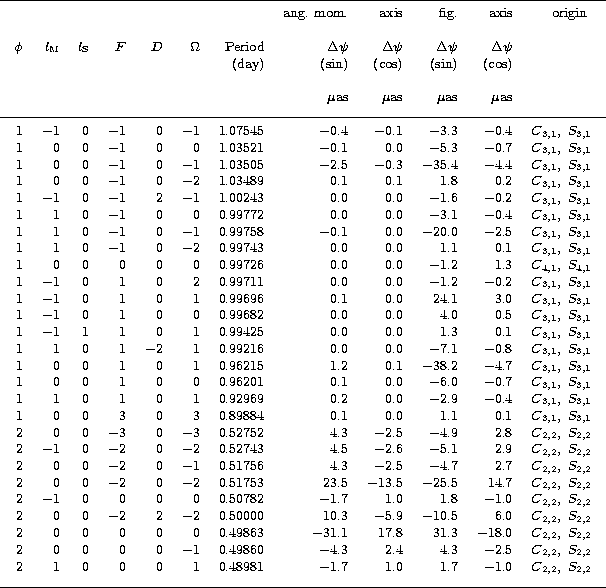 |
 |
So it seems necessary to remind of this property, in order to avoid any misunderstanding
concerning the tables, where the opposite sign between the values for the angular momentum
axis and those for the figure axis, might be interpreted as an error.
In Table 7.1, all the coefficients of rigid-Earth nutation in ![]() up to
up to
![]() due to the triaxiality of the Earth, marked by the symbol CS22, have been
gathered together with the coefficients coming from the C3,i and S3,i
geopotential, which will be studied in the next section. C3,2 and S3,2 give also
birth to quasi semi-diurnal components of nutation, which do not reach the
due to the triaxiality of the Earth, marked by the symbol CS22, have been
gathered together with the coefficients coming from the C3,i and S3,i
geopotential, which will be studied in the next section. C3,2 and S3,2 give also
birth to quasi semi-diurnal components of nutation, which do not reach the ![]() level. Table 7.2 is the table corresponding to Table 7.1, in obliquity.
level. Table 7.2 is the table corresponding to Table 7.1, in obliquity.
Terms due to C3,i and S3,i, i = 1,3.
The terms of nutation related to the geopotential harmonics C3,i and S3,i
have been computed for the first time recently, by Bretagnon et al. (1997), and can
be ranged into three categories: the quasi-diurnal terms, which originate from C3,1
and S3,1, the quasi semi-diurnal terms, which originate from C3,2
and S3,2, and at last the quasi 1/3 d periodic terms, which originate
from C3,3 and S3,3. One of the specific properties of
the diurnal terms is that the amplitudes of the angular momentum components is
much smaller than the amplitude of the component which is the figure axis counterpart.
In other words, the Oppolzer terms are themselves much bigger than the amplitude of the
nutation of the angular momentum, which is not the case of all the other nutations,
for which it is by one or two orders smaller, when non negligible (except the
contribution of C2,2 and S2,2, for which the order is the same).
Folgueira et al. (1998a) calculated the contribution of the C3,i's and S3,i's
with the help of Hamiltonian canonical equations, following the same way of calculation
as Kinoshita (1977). It can be seen from these calculations that the relatively large
amplitude of Oppolzer terms comes from the fact that some components in the determining
function W do not contain the variable g at the denominator
(g has a nearly diurnal period), so that they keep on
remaining big after integration. Here also the agreement for the three kinds of contribution
is very good between the results found and Bretagnon et al. (1997), as is shown in a
comparative table (Souchay 1997). Notice that the largest diurnal component has an amplitude
of ![]() in longitude and
in longitude and ![]() in obliquity, with respective arguments
in obliquity, with respective arguments
![]() where:
where: ![]() . The
characterization of the angle
. The
characterization of the angle ![]() will be given in the chapter 6.
Concerning the contribution studied here, the tables in REN-2000 are the same as in
Folgueira et al. (1998a) when the phases
will be given in the chapter 6.
Concerning the contribution studied here, the tables in REN-2000 are the same as in
Folgueira et al. (1998a) when the phases ![]() have been replaced in each
argument by their numerical value so that the nutation terms are split into sine and
cosine components. In Tables 7.1 and 7.2, we show the largest of the nutations from
C3,1 and S3,1, respectively in longitude and in obliquity, indicated by the
symbol CS31.
have been replaced in each
argument by their numerical value so that the nutation terms are split into sine and
cosine components. In Tables 7.1 and 7.2, we show the largest of the nutations from
C3,1 and S3,1, respectively in longitude and in obliquity, indicated by the
symbol CS31.
Terms due to C4,i and S4,i, i = 1,4.
They have been computed by Bretagnon et al. (1997) and by
Folgueira et al. (1998b).
The coefficients retained in the tables REN-2000 are coming from this last paper.
Only 5 components are larger than ![]() (3 for
(3 for ![]() and 2 for
and 2 for ![]() ). The leading one can be written, in
). The leading one can be written, in ![]() :
: ![]() , and:
, and: ![]() For these terms also the amplitude of the coefficients is much bigger for the figure axis than for
the axis of angular momentum.
For these terms also the amplitude of the coefficients is much bigger for the figure axis than for
the axis of angular momentum.
Copyright The European Southern Observatory (ESO)